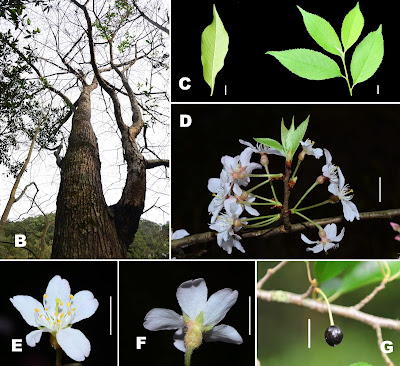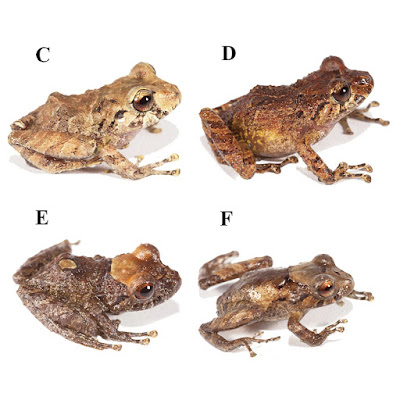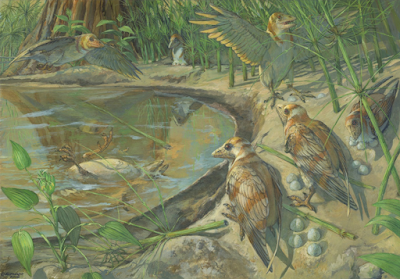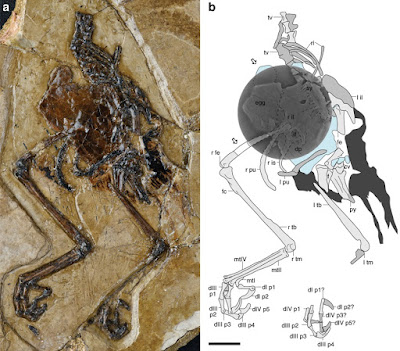[Most Recent Entries] [Calendar View]
Wednesday, March 20th, 2019
| Time | Event | ||||
| 3:52a | [Invertebrate • 2019] Branchiosyllis belchiori & B. gonzaguinhai • Two New Sponge-associated Branchiosyllis (Annelida: Syllidae: Syllinae) from Northeastern Brazil
Abstract Here we describe two new species in the genus Branchiosyllis Ehlers, 1887 associated with sponges. Branchiosyllis belchiori sp. nov. was found in Todos os Santos Bay, state of Bahia, and in the Fernando de Noronha Island (Northeastern Brazil), and Branchiosyllis gonzaguinhai sp. nov. was found in the Fernando de Noronha Island and Rocas Atoll. We compare the species herein described with their morphologically most similar congeners and provide a synoptic table of the morphological variation among the type-series of the two new species. An identification key for the species of Branchiosyllis recorded in Brazil is also provided. Keywords: Annelida, Islands, Fernando de Noronha, Taxonomy, Atlantic Ocean, Polychaeta Rodolfo Leandro Nascimento, Marcelo Veronesi Fukuda and Paulo Cesar de Paiva. 2019. Two New Sponge-associated Branchiosyllis (Annelida: Syllidae: Syllinae) from Northeastern Brazil. Zootaxa. 4568(2); 307–322. DOI: 10.11646/zootaxa.4568.2.6 | ||||
| 11:37a | [Botany • 2019] Prunus sunhangii (Rosaceae) • A New Species of Prunus from central China
Abstract A new species of Rosaceae from Central China, Prunus sunhangii D. G. Zhang & T. Deng, sp. nov., is described and illustrated. The new species is placed in Prunus subgenus Cerasus by flower and fruit characteristics. It is most similar to Prunus cerasoides, but differs by having longitudinally 2-lobed apical petals, an acuminate leaf apex, 17–25 stamens, white petals, dark black drupes, brown hypanthium, and different phenology. The phylogenetic placement of this species was assessed based on morphological and molecular data. Molecular analysis (cpDNA + ITS) corroborated its placement in subgenus Cerasus, specifically Prunus section Serrula. Keywords: Phylogenetic analyses, Taxonomy, Cerasus, Section Serrula Prunus sunhangii D. G. Zhang & T. Deng, sp. nov. Diagnosis: P. sunhangii is easily differentiated from P. cerasoides by its apically longitudinally 2-lobed petals and other features: white flowers, black drupe, stamens number (17–25), brown hypanthium and with phenology. Distribution and habitat — P. sunhangii is restricted to the Wuling Mountains in South China, which is a center of the Metasequoia Flora (Chen et al., 2017). Plants were growing on limestone soil, scattered along a slope adjoining the valley at 300–600 m in Hunan province and at 1000–1200 m in Hubei province (Fig. 4). Etymology – The epithet of the new species refers to the chinese botanist Prof. Hang Sun, who made a significant contribution to our knowledge of the flora of China. Vernacular name - Chinese mandarin: Sūn Háng Yīng (孙航樱). Xiaoshuang Zhang, Zhilin Jiang, Ziyoviddin Yusupov, Menghua Zhang, Daigui Zhang, Komiljon Tojibaev, Ying Meng and Tao Deng. 2019. Prunus sunhangii: A New Species of Prunus from central China. Plant Diversity. 41(1); 19-25. DOI: 10.1016/j.pld.2019.01.003 | ||||
| 11:44a | [Herpetology • 2019] Pristimantis mallii • A New Species of Terrestrial Frog Pristimantis (Strabomantidae) from the upper Basin of the Pastaza River, Ecuador
Abstract We describe a new species of Pristimantis from the montane forest of the Río Zuñag Ecological Reserve, upper basin of the Pastaza River, Ecuador. Pristimantis mallii sp. n. is characterized by a snout-vent length of 11.6–21.3 mm in adult males (n = 12), 22.6–34.3 mm in adult females (n = 8), and is compared morphologically and genetically with Pristimantis miktos and with other relevant species of Pristimantis. The new species is characterized by having skin on dorsum and flanks shagreen, distinctive scapular folds, snout broadly rounded in dorsal view, upper eyelid bearing one or two subconical tubercles and some rounded tubercles, dorsum and flanks light brown to brown, with irregular dark brown marks bounded by dirty cream and groin with irregular yellowish marks. Keywords: Montane forest, Pristimantis mallii sp. n., Río Zuñag Reserve, Terrarana  Pristimantis mallii sp. n. Proposed standard English name: Malli’s Rain Frog Proposed standard Spanish name: Cutín de Malli Diagnosis: A new species of Pristimantis having the following combination of characters: (1) skin on dorsum and flanks shagreen, with rounded tubercles scattered towards the axillary region, with “) (” shaped scapular folds (evident in life); dorsolateral folds absent; skin on venter areolate; discoidal fold slightly defined; (2) tympanic membrane and tympanic annulus present, round, equivalent to 45% of ED; supratympanic fold present; (3) snout broadly rounded in dorsal view, moderate in length and rounded in lateral view; (4) upper eyelid with one or two subconical tubercles on the center of eyelid and some rounded tubercles (less evident in preserved specimens); EW 100% of IOD; cranial crests absent (5) dentigerous processes of vomers oblique in outline, with five to seven teeth, moderately separated, posteromedial to choanae; (6) vocals slits and nuptial pads present; (7) Finger I shorter that Finger II; discs of digits expanded, truncate; two times the width of the digits on Fingers III and IV; (8) fingers with lateral fringes; (9) ulnar tubercles present, rounded; (10) heel bearing one or two subconical tubercles (less evident in preserved specimens) surrounded by few lower rounded tubercles; inner tarsal fold present, it extends up to 1/4 of the tarsus; (11) inner metatarsal tubercle oval, 5–6× as large as outer metatarsal tubercle that is subconical; supernumerary plantar tubercles indistinct; (12) toes with slightly defined lateral fringes; webbing absent; Toe V longer that Toe III, disc on Toe V reach the distal subarticular tubercle on Toe IV; (13) in life, dorsum and flanks light brown to brown, with irregular dark brown marks bounded by dirty cream, light brown or greenish cream; hidden surfaces of thighs brown splashed with dirty cream; groin with irregular yellowish marks; venter light gray or cream, spotted to densely spotted with brown. Golden coppery iris with black reticulations and a reddish-brown horizontal stripe; (14) SVL in adult males 16.7 ± 4.5 (11.6–21.3 mm); females with 27.6 ± 3.9 (22.6–34.3).  Distribution and natural history: Pristimantis mallii is only known from Fundación EcoMinga’s Río Zuñag Ecological Reserve, which is located in the southeastern buffer zone of the Llanganates National Park, in Baños, Río Negro, Tungurahua province, in the upper basin of the Pastaza River, on the east-central slope of the Andes in Ecuador. This locality comprises montane cloud forest (MAE 2012). The elevation range is 1300–2190 m above sea level.All specimens were found on herbaceous and shrub vegetation inside mature forest, where they perched on herbs, shrubs, palms, ferns, bromeliads and Araceae between 100 and 450 cm above the ground. A couple in amplexus was found in January 2012, and the female deposited an egg clutch in a field bag, in the time passed between being collected in the field and reaching the base camp. Additionally, two couples in amplexus and an adult female were found in October 2017. Etymology: The new species is named in honor of the late Dr V. N. Mallikarjuna “Malli” Rao, of Wilmington, Delaware, USA. A winner of the Lavosier Medal at DuPont, he helped develop an environmentally safe alternative to the fluorocarbons that were depleting the ozone layer. His donation to EcoMinga in 2007 started the Río Zuñag Reserve, the type locality of P. mallii. Carolina Reyes-Puig, Juan Pablo Reyes-Puig, Daniel A. Velarde-Garcéz, Nicolás Dávalos, Emilio Mancero, María José Navarrete, Mario H. Yánez-Muñoz, Diego F. Cisneros-Heredia and Santiago R. Ron. 2019. A New Species of Terrestrial Frog Pristimantis (Strabomantidae) from the upper Basin of the Pastaza River, Ecuador. ZooKeys. 832: 113-133. DOI: 10.3897/zookeys.832.30874 Palabras clave: Bosque montano, Pristimantis mallii sp. n., Reserva Río Zuñag, Terrarana | ||||
| 11:53a | [PaleoOrnithology • 2019] Avimaia schweitzerae • An Early Cretaceous Enantiornithine (Aves) Preserving An Unlaid Egg and Probable Medullary Bone
Abstract Understanding non-crown dinosaur reproduction is hindered by a paucity of directly associated adults with reproductive traces. Here we describe a new enantiornithine, Avimaia schweitzerae gen. et sp. nov., from the Lower Cretaceous Xiagou Formation with an unlaid egg two-dimensionally preserved within the abdominothoracic cavity. Ground-sections reveal abnormal eggshell proportions, and multiple eggshell layers best interpreted as a multi-layered egg resulting from prolonged oviductal retention. Fragments of the shell membrane and cuticle are both preserved. SEM reveals that the cuticle consists of nanostructures resembling those found in neornithine eggs adapted for infection-prone environments, which are hypothesized to represent the ancestral avian condition. The femur preserves small amounts of probable medullary bone, a tissue found today only in reproductively active female birds. To our knowledge, no other occurrence of Mesozoic medullary bone is associated with indications of reproductive activity, such as a preserved egg, making our identification unique, and strongly supported.
Systematic paleontology Aves Linnaeus, 1758 Pygostylia Chiappe, 2002 Ornithothoraces Chiappe, 1995 Enantiornithes Walker, 1981 Avimaia schweitzerae gen. et sp. nov. Etymology: The generic name Avi- (bird) maia (mother) refers to the fact the specimen is a female preserved with an egg in the body cavity. Schweitzerae is in honor of Mary Higby Schweitzer for her ground-breaking works on MB and for her role in establishing the field of molecular paleontology. Holotype: IVPP V25371 (Institute of Vertebrate Paleontology and Paleoanthropology), an articulated partial skeleton with some feather traces, consisting of the caudal half of the axial column, the pelvis, and the hind limbs, mostly exposed ventrolaterally (Fig. 1). Locality and horizon: Near Changma Village, Yumen City, Gansu Province, northwestern China; Lower Cretaceous (lower–middle Aptian) Xiagou Formation10. Diagnosis: Small-bodied enantiornithine (robust, cranially forked pygostyle, distal condyles of tibiotarsus contacting medially, J-shaped metatarsal I, metatarsal IV mediolaterally reduced relative to metatarsals III and IV, metatarsal IV trochlea reduced to single condyle) with the following autapomorphies: pubis delicate and strongly curved so that the caudal margin is concave throughout; distal end of ischium dorsally curved. Alida M. Bailleul, Jingmai O’Connor, Shukang Zhang, Zhiheng Li, Qiang Wang, Matthew C. Lamanna, Xufeng Zhu and Zhonghe Zhou. 2019. An Early Cretaceous Enantiornithine (Aves) Preserving An Unlaid Egg and Probable Medullary Bone. Nature Communications. volume 10, 1275. DOI: 10.1038/s41467-019-09259-x New Cretaceous Fossil Sheds Light on Avian Reproduction - english.cas.cn/newsroom/research_news/20 New Cretaceous fossil sheds light on avian reproduction eurekalert.org/e/933b via @EurekAlert |
| << Previous Day |
2019/03/20 [Calendar] |
Next Day >> |














